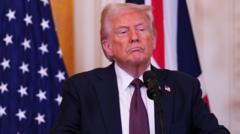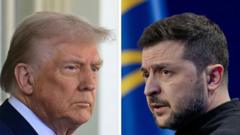The US has allocated $20 billion in economic support to Ukraine, derived from seized Russian assets, as part of a broader $50 billion G7 commitment. The funds are meant to assist Ukraine during a critical phase of its conflict with Russia, although future assistance may be uncertain under the incoming Trump administration.
US Allocates $20bn to Ukraine Funded by Frozen Russian Assets

US Allocates $20bn to Ukraine Funded by Frozen Russian Assets
Efforts to support Ukraine continue as the US channels seized Russian funds into a World Bank fund amidst concerns over future military aid.
The US has recently disbursed $20 billion (£15 billion) to Ukraine, with financing sourced from the profits of Russian assets that have been frozen due to the ongoing conflict. This funding plays a crucial role in a larger $50 billion (£39 billion) assistance package that was finalized by G7 member nations this past June. In remarks regarding the financial support, US Treasury Secretary Janet Yellen emphasized that leveraging these seized assets means that Russia will "shoulder the burden of its unlawful aggression," instead of placing that cost on American taxpayers.
This development comes just weeks ahead of the expected transition of presidential power from Joe Biden to Donald Trump, who has expressed intentions to swiftly conclude the conflict in Ukraine. Trump has previously characterized financial contributions to Ukraine as excessive and burdensome, raising questions about the future of such support under his administration.
The US Treasury confirmed on Tuesday that the $20 billion has been deposited into a World Bank fund, which Ukraine can access for various needs, though military expenses are excluded. Initially, the current administration had aimed to allocate half of these funds toward military aid for Ukraine, a plan that would have necessitated congressional approval. However, political disagreements in the House of Representatives resulted in significant delays before $61 billion in military aid for the nation was finally sanctioned back in April.
Recent discussions among US and allied officials, including members of the EU, have focused on the strategic use of approximately $325 billion (£276 billion) of assets frozen in response to Russia’s full invasion of Ukraine beginning in 2022. Last October, the G7 reached an agreement to deploy the interest generated by these assets—an estimated $3 billion (£2.4 billion) annually—to fund Ukraine with a $50 billion credit line over 30 years, with initial payments anticipated by year’s end. The EU has pledged more than €18 billion (£15 billion) in similar funding structures.
The recent financial infusion comes at a pivotal moment for Ukrainian President Volodymyr Zelensky and his military, which has faced significant territorial losses lately. According to reports, Moscow is regaining ground in the eastern parts of Ukraine, and Ukrainian forces have depicted a grim situation along battlefronts as they strive to maintain their defenses against Russian offensive strategies.























